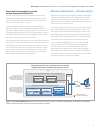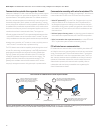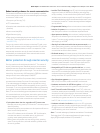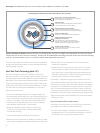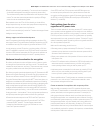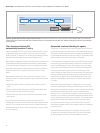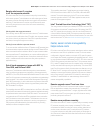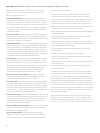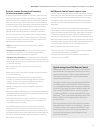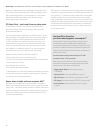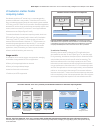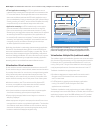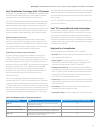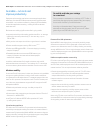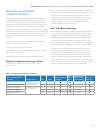16
White Paper: The All New 2010 Intel® Core™ vPro™ Processor Family: Intelligence that Adapts to Your Needs
Problem-resolution capabilities in PCs with a new Intel Core vPro
processor can help IT managers reduce deskside visits by up to
56%
12
through features such as:
• Remote/redirected boot, through integrated drive electronics
redirect (IDE-R). IDE-R allows authorized IT technicians to remotely
boot a PC to a clean state, or redirect the boot device for a problem
PC to a clean image on local storage, on a CD at the help desk, or to
an image on another remote drive. There is no need for a deskside
visit or service depot call to resolve many boot, OS, and software
remediation problems.
• Console redirection, through Serial-Over-LAN (SOL). Technicians now
have remote keyboard control of a PC outside of standard OS control,
allowing them to perform tasks such as editing BIOS settings from the
service center – without user participation.
• KVM Remote Control,
2
a new hardware-based feature that works for
wired and wireless PCs (that have integrated Intel HD Graphics) both
inside and outside the corporate firewall. KVM allows an authorized
IT technician to remotely control the keyboard, video, and mouse of a
remote PC, as if they were deskside, at the PC itself. This feature helps
IT remotely resolve the most complex software failures and eliminates
the need for a separate, costly data-center KVM switch.
• PC Alarm Clock, a new hardware-based feature that lets IT schedule
a PC to wake itself from any powered down or sleep state. The PC can
then perform tasks based on IT policy, such as initiate a secure call to
the service center for automated, off-hour services – even if outside
the corporate firewall. The feature allows independent software
vendors (ISVs), such as McAfee, to enable IT-scheduled product
updates even for businesses that don’t have an IT console.
• Out-of-band, policy-based alerting, so the PC can send alerts
and Simple Network Management Protocol (SNMP) traps to the
management console anytime, based on IT policies.
• Fast call for help for wired or wireless systems, even beyond the fire-
wall. Helps users avoid the costly downtime of shipping PCs back to IT
to be fixed. If a PC crashes, a user can phone IT for help and, during the
boot process, press a specific key to securely connect the PC to IT for
troubleshooting. IT can then take over via remote console redirection
or through hardware-based KVM Remote Control.
• Persistent event logs, stored in dedicated memory (not on the hard
drive) so the information is available anytime. IT technicians can now
access the list of events that occurred even before a hardware or
software problem was noticed, including events that occurred
before a PC connected to the network.
• Always-available asset information, stored in dedicated, protected
memory. This information is updated every time the system goes
through power-on self test (POST).
• Access to preboot BIOS configuration information anytime.
Diagnostics and repair processes can also be securely performed
on wired and wireless PCs – even outside the corporate firewall.
17
IT technicians can now remotely:
• Access asset information anytime, to identify “missing” or failed
hardware components, and verify software version information.
• Guide a PC through a troubleshooting session without requiring user
participation – even for complex issues such as BIOS issues, blue-
screens, freezes, patch failures, and other “edge” software issues.
• Reboot a system to a clean state, or redirect the PC’s boot device to
a diagnostics or remediation server (or other device).
• Watch as BIOS, drivers, and the OS attempt to load, to identify problems
with the boot process.
• Update BIOS settings, identify BIOS versions, or push a new BIOS
version to the PC to resolve a particular problem.
• Upload the persistent event log to identify the sequence of events
(such as temperature spikes or an unauthorized software download)
that occurred before the system failed.
• Push new copies of missing or corrupted files, such as .DLL files,
to restore an OS.
• Rebuild the OS or fully reimage the hard drive remotely.
• Perform OS migrations and application upgrades, and troubleshoot
upgrade problems remotely.
• Power-manage PCs more effectively to lower power consumption and
reduce energy costs.
• Schedule a local wake from a full power down, to prepare systems
for incoming workers.
If a system becomes inoperable, a technician can use secure remote
and/or redirected boot or a secure PXE boot to change the system’s
boot device to a CD or to an image located on a remote network drive –
without leaving the service center. The technician can then use secure
console redirection to remotely guide the PC through a troubleshoot-
ing session. If a user application has become corrupted, the technician
can remotely reimage the user’s hard drive and restore user data from
known-good files, overwriting corrupt or problem files. The user is back
up and running as quickly and efficiently as possible without a service
depot call or deskside visit.
Many case studies have shown how PCs with a new Intel Core vPro
processor can help substantially reduce IT service costs for problem
resolution and software updates (refer to the Intel Web site, www.intel.
com/references/ecm/index.htm, for case studies in various industries).




